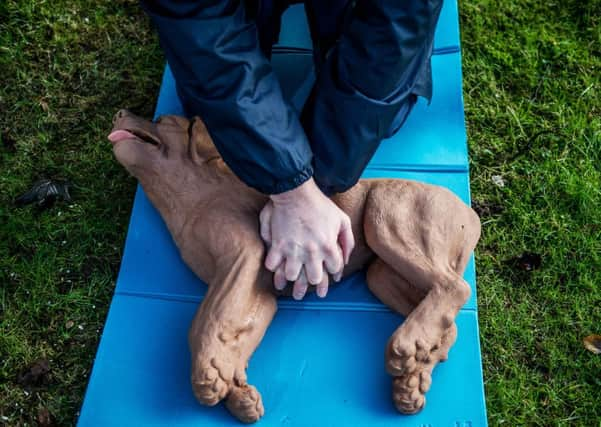High demand to learn CPR to save animals in emergencies


But an increasing number of pet owners are flocking to train as “canine first responders” to treat stricken dogs and cats.
The courses, run mainly by first aid professionals who have branched out into pet care, include information on how to perform cardiopulmonary resuscitation on a dog, using a special canine mannequin akin to the “Resusci Annie” used in human first aid training.
Advertisement
Hide AdAdvertisement
Hide AdTrainers say the number of people signing up for the courses, which have been popular in the US for some time, has soared recently, prompted by a growth in pet minding businesses. Almost one in four UK households owns a dog.
Stuart Knox, who runs Central First Aid in Paisley, which offers workplace first aid courses for humans, branched out into canine first aid courses after his stepdaughter began studying animal care.
“She was also a dog walker and realised there was a need for it,” he said. “I think the rise in businesses such as dog walking and day care has fuelled the demand for courses like this. There is a real sense of responsibility. You’re basically looking after someone else’s child – whether it is a human child or a dog.”
Knox studied online modules in canine first aid with an English company and invested in a CPR dog, known as Casper. He has trained around 50 people in canine first aid and has more courses planned for later this month. “It’s not that different to doing CPR on a human,” he said.
Paramedic Ian Conway, partner at Forth Training in South Queensferry, said that customers had asked him about canine first aid courses, prompting him to attend a talk by a trainer in England.
“We are basically a group of paramedics who work on humans and we were very sceptical,” he said. “Then when we heard more, we realised it was actually very good. We are getting a lot of canine professionals – people who own kennels and doggy day care businesses.”
The courses follow the same protocols that vets would use if they were first on the scene of a canine emergency, teaching pet lovers to control bleeding, manage a dog’s choking and how to resuscitate an animal which has stopped breathing.
Conway added: “The courses are not in lieu of a vet appointment – they are to enable you to get to a vet. Everything we teach people to do with humans we can do with animals too.”
Advertisement
Hide AdAdvertisement
Hide AdGudrun Ravetz, president of the British Veterinary Association, said: “Veterinary practices offer a 24-hour first aid service, however, as with human first aid, knowing the basics of what to do in an emergency is a good idea.
“If canine first aid courses are run by someone with an understanding and experience of canine anatomy, physiology and correct procedures for canines, these courses can offer helpful and potentially life-saving tools to stabilise their injured pet until they are able to get to a vet for professional care, and could save lives.”